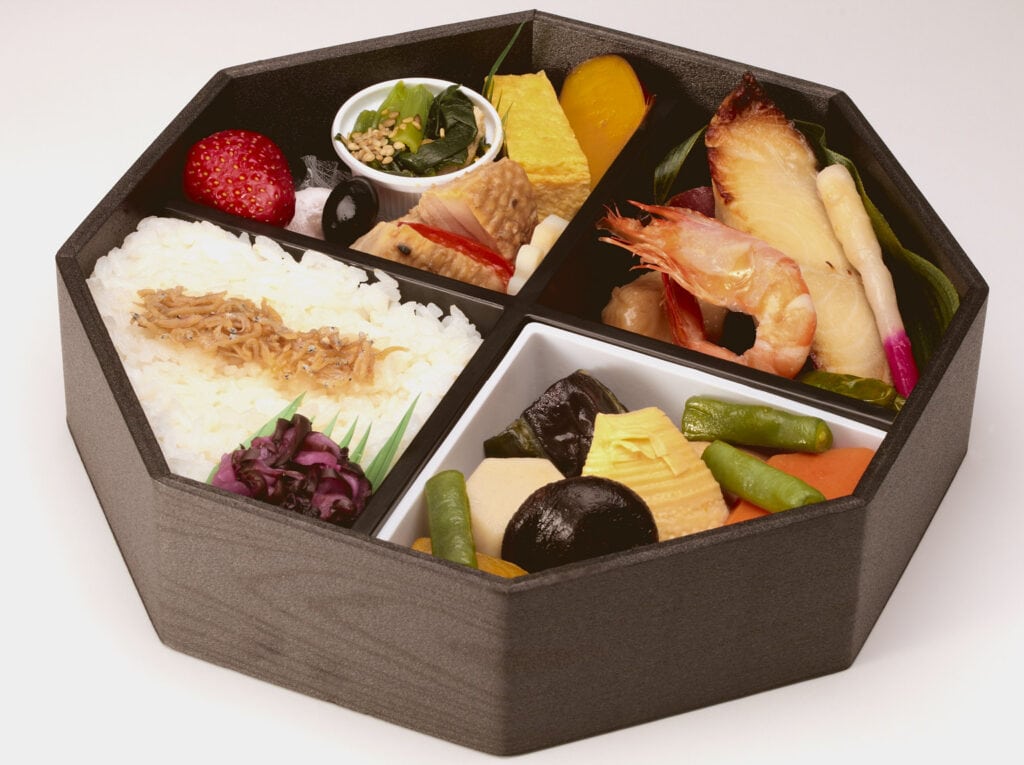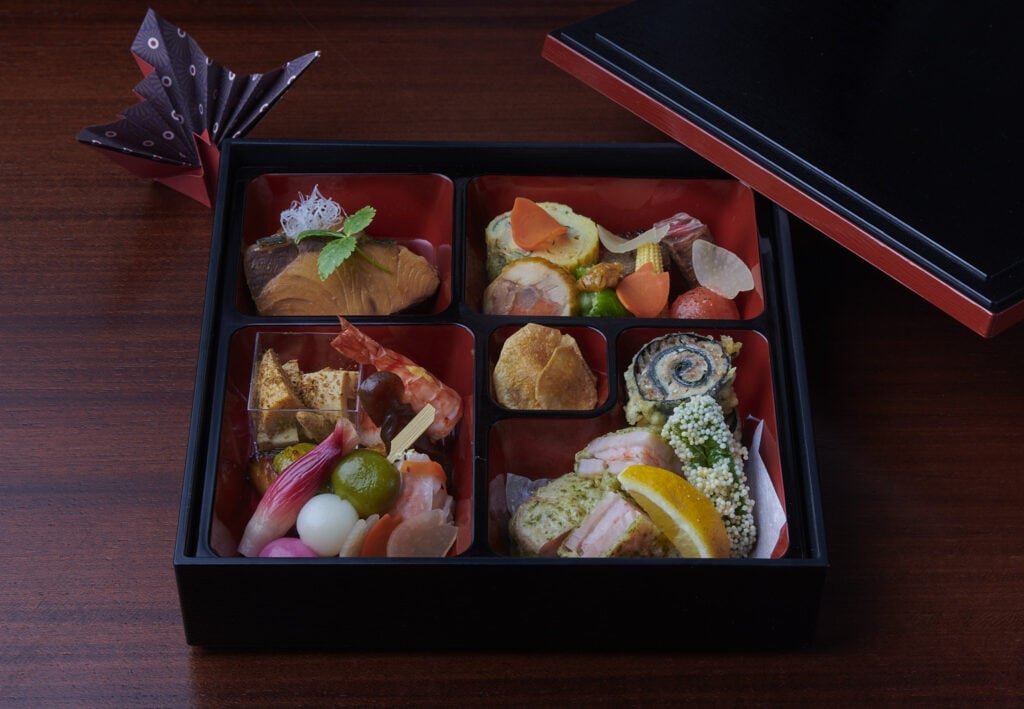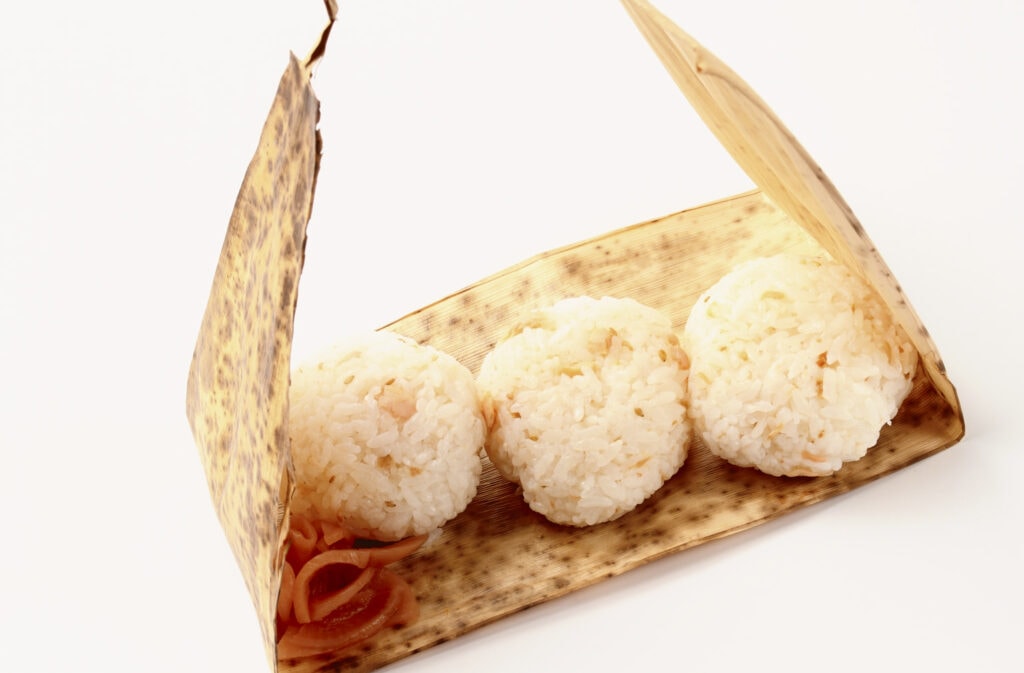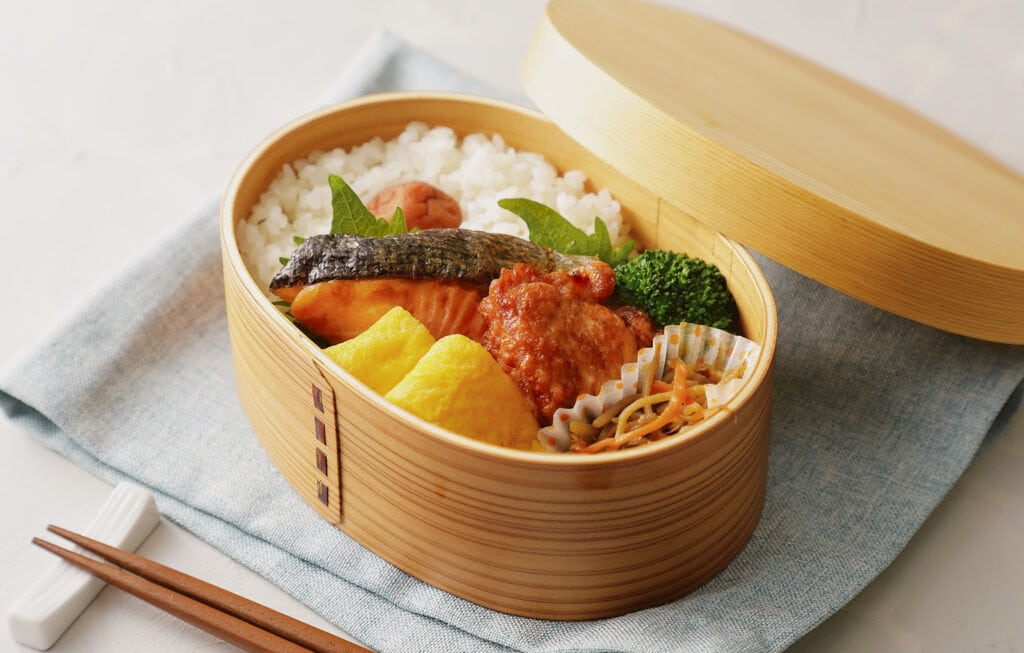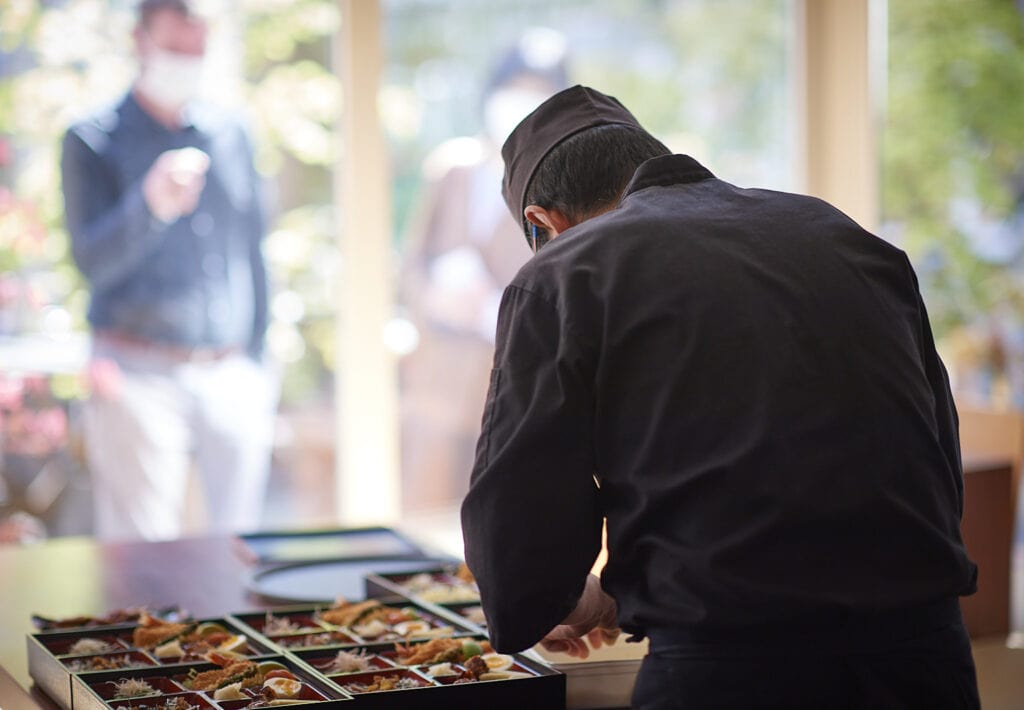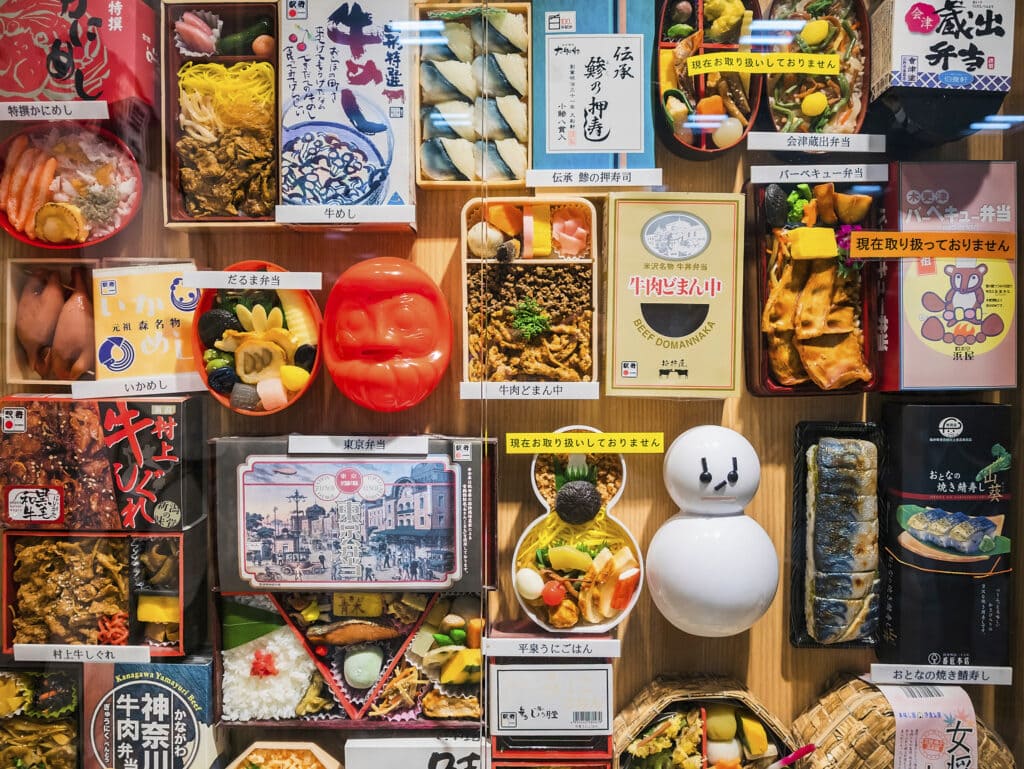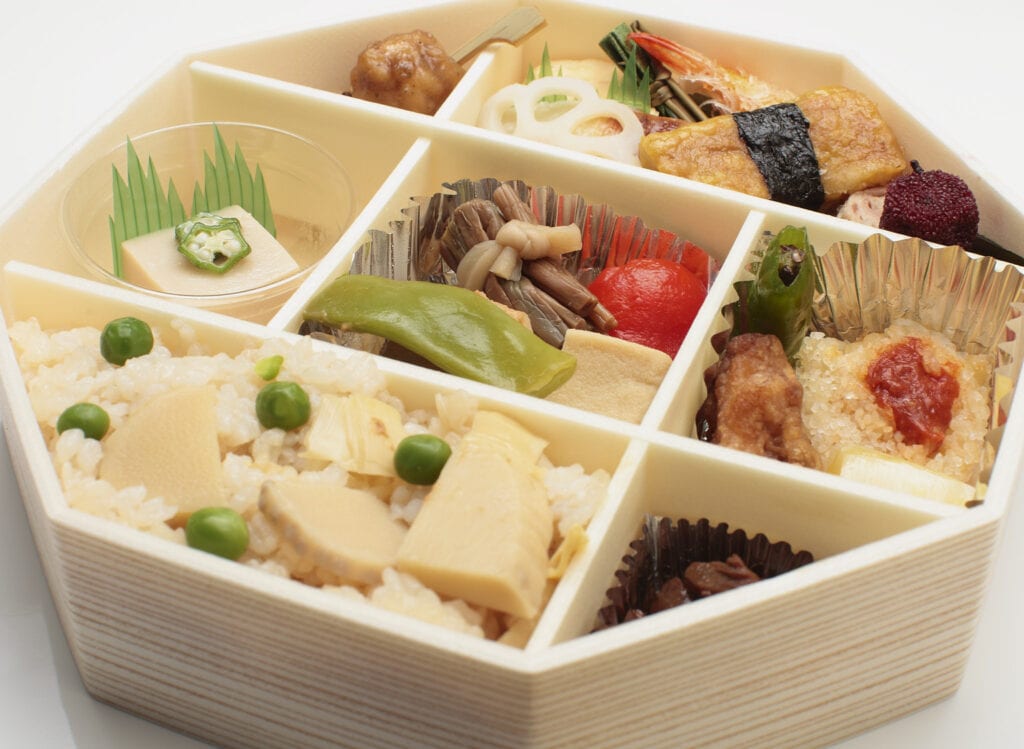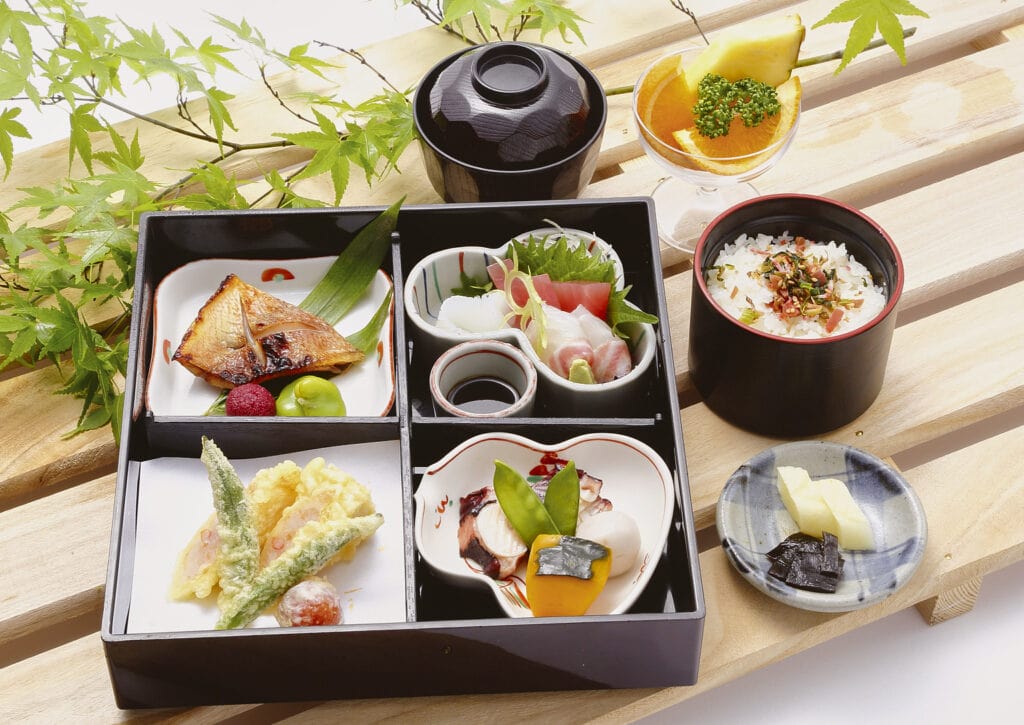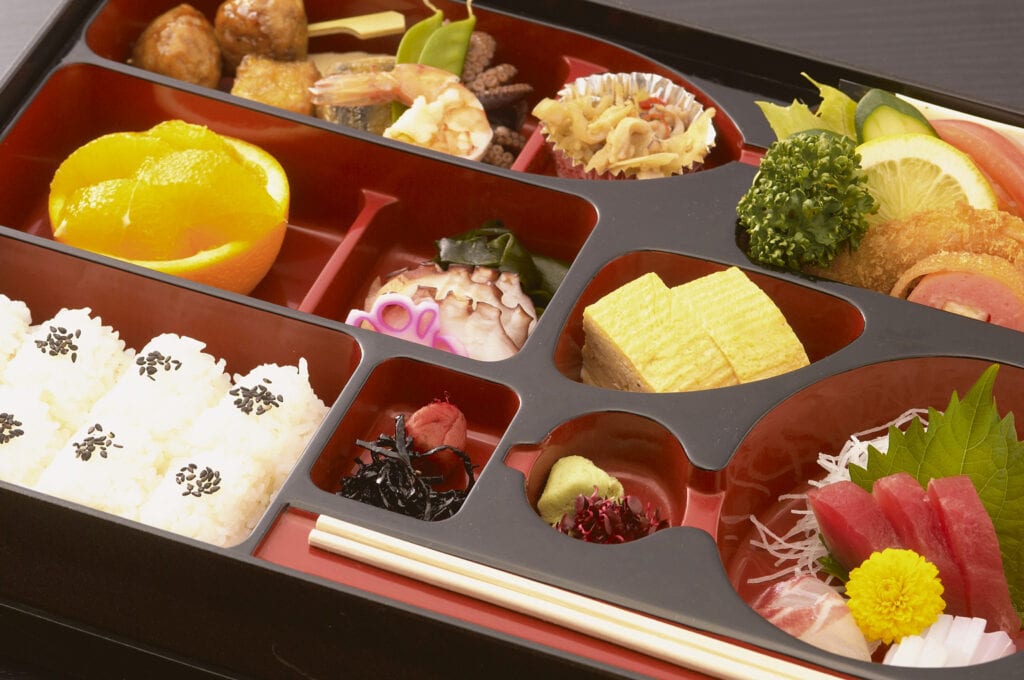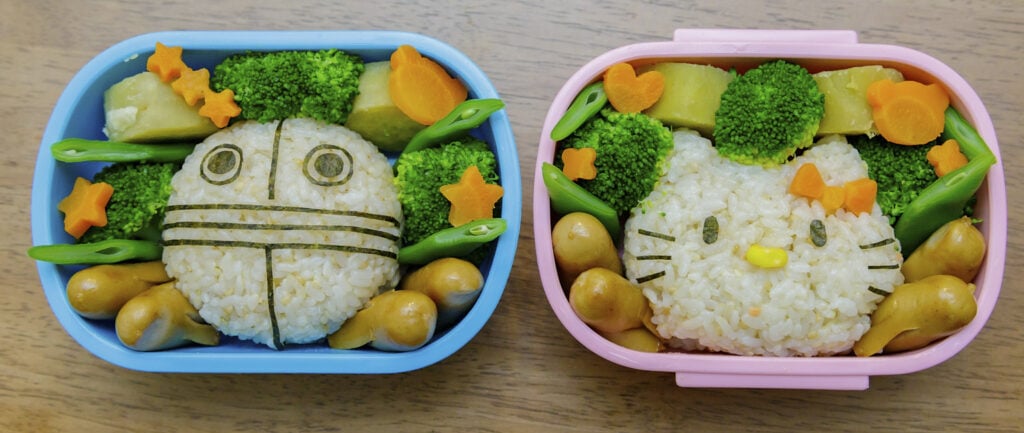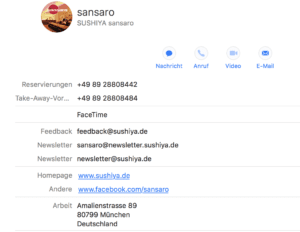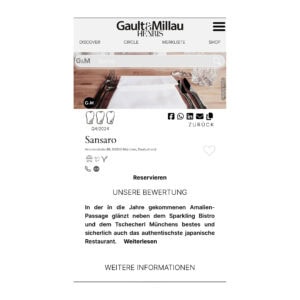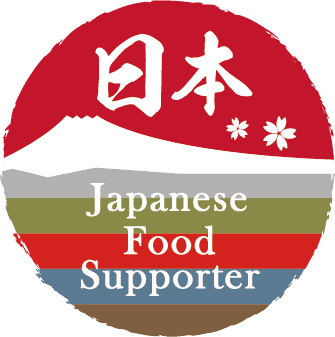What is Bentō?
A Bentō is in Japan what the Butterstulle is in Germany - but on a much higher level.
Because where the buttered sandwich is simply meant to fill you up and be nutritious, each Bentō is a little work of art. The eye eats with you, as is customary in Japanese cuisine. Home-made Bentō naturally look somewhat different from the Bentō offered by restaurants, hotels and specialized stores.
Important to know: Bentō(-box) refers to both the entire take-out meal and the container, i.e., the "snack box." In Japanese, the pure box without contents, i.e. the non-edible container, is sometimes called Bentō-bako (弁当箱) to differentiate it.
There are many different shapes and styles of Bentō, from the simplest boxes made at home for school children to the haute cuisine of top chefs in fine boxes made of Japanese cedar.
Classic Bentō usually includes rice as a filling food.
The side dishes, carefully composed of various vegetables, tofu, egg, fish and meat, and often a fruity dessert, are tastefully and aesthetically coordinated.
In terms of nutritional value, quantity and calorie content, a Bentō is a full meal. And that in turn clearly distinguishes it from the buttered sandwich, which fills you up and provides energy, but is often not balanced.
Where does the word Bentō come from?
The word Bentō comes from the Japanese language. A way food was already known in Japan in the fifth century, however, the food was transported in the past still in simple baskets or in cloths. A stylishly wrapped Bentō is still wrapped in the furoshiki today. The concept of the Bentō, however, as we know it today, did not appear until the Azuchi-Momoyama period (1573 - 1603). During this warlike period, commander Oda Nobunaga had the people supplied with provisions in boxes made of lacquered wood.
What does Bentō mean?
The word Bentō (弁当) refers on the one hand to the meal for on the go, and on the other hand to the box in which this food is stored and transported, which in many cases also serves as eating utensils.
So first of all, Bentō means "takeaway food."
How to write Bentō?
Bentō is written with two kanji. Kanji are the Sino-Japanese characters that carry both sound and meaning. In the case of the Bentō (弁当), the takeaway is composed of the kanji for "language," "dialect," "distinction," or "leaf" (Ben 弁) and the kanji for the verb "to meet" or "to apply" (tō, ateru, or ataru 当).
The direct translation of the word "Bentō" is thus quite a poetic matter: people meet (to eat together), come together, and linguistically as well.
This is because Japan was and is strongly characterized by dialects, especially in rural regions.
Interpreted more down-to-earth, however, Bentō (弁当) then simply means that the food was probably first wrapped in leaves to be transported...
What's in a Bentō box?
What exactly a Bentō box can hold is, of course, defined by the design of the box. Most boxes for household use hold about 1,000 milliliters. If restaurants and specialized stores prepare the boxes, there are of course other possibilities than in private households.
Nutritionally balanced composition
A Bentō is usually assembled according to the "3:2:1 rule".
In terms of volume, there are three parts carbohydrates to two parts proteins and two parts other. Other includes fruits and vegetables.
Notes for Bentō freaks: in non-Japanese countries a 4:2:1 rule is also mentioned again and again.
However, we could not find any sources on this in Japan, so we are not sure if this 4:2:1 rule really exists, or if on the internet some people copied incorrectly from each other? As always, if you have a question or a different level of knowledge, feel free to write us! We gratefully follow up every hint...
Room temperature food
Bentō is usually eaten at room temperature.
The selection of the individual dishes takes this into account: Only what tastes good at room temperature goes into the box. At least, that is the classic - however, thermal boxes are now also sold in Japan, in which the Bentō remains warm (or cold in the hot summer) for a few hours.
Typical Japanese: 5 flavors
Just as important as the nutritional balance is the flavor balance. All five flavors are included in Bentō:
- sweet (mostly sweet-mild vegetables)
- sour (pickled vegetables for example)
- Salty (often already given by the soy sauce accompanying the side dishes).
- bitter (perhaps given by a topping of herbs)
- spicy (for example, by meat or vegetables in a hot sauce)
By the way, the number five appears again and again in many places in Japanese cuisine - read more in our article about Washoku.
Rice is actually always there
The rice neutralizes the taste between the individual dishes and ensures that the taste senses are not overwhelmed. The Bentō also has a varied color scheme. Red and yellow hues naturally occur in an aesthetic combination with green, white and black.
What kind of shapes and boxes are available for Bentō?
In the household Bentō boxes are common plastic, thermal boxes are usually made of double-walled metal with an insulating layer in between. There are both boxes with a compartment division in the surface and boxes that are stacked on top of each other. Here, each layer is a single compartment.
The Bentō from the professional sector looks somewhat different.
While in the supermarket and convenience store (for example at Family Mart) often inexpensive plastic packaging is used, boxes made of cedar wood, lacquerware or bamboo are common in the area of upscale cuisine. In general, the more noble the dishes that are put together, the higher the quality of the box.
With regard to the typical styles, quite different variants have developed throughout history:
- Eki-ben (駅弁): Bentō sold at and near train stations, specifically targeted at travelers. Inexpensive disposable packaging can replace the high-end boxes. In Japan, eki ben are among the typical, regionally varied specialties that usually make train travel a great pleasure.
- Makunouchi Bentō (幕の内弁当): Makunouchi is used to refer to the contents of the box, not the box itself. This form of bento is easy to recognize: Rice and side dishes are placed together in one box. There can be a partition between them, but there doesn't have to be. Lacquerware is not usually used for this form of bento; instead, plainer materials are used. The term "makunouchi bento" was coined in the late Edo period (1603-1867) to describe the elaborate bento that combined white rice with side dishes and was more elaborate than a simple onigiri. It is sometimes defined as a generic term for "Bentō that appeared in the theatrical culture of the Edo period." Initially made for actors and backstage personnel during theatrical performances, they eventually evolved with the advent of audience-oriented products. Eventually, these lunchboxes became standardized and mass-produced.
- Shōkadō Bentō (松花堂弁当): The box, usually made of lacquerware or wood, has an evenly spaced interior compartment. However, the individual dishes are not simply placed in the inner compartments, but each is placed in a bowl or on a small plate in the respective compartment.
- Wariko Bentō (割子弁当): Wariko is the Japanese term for the interior partitions of the compartments. So here we are talking about boxes made of lacquerware or wood that have partitions inside. Unlike the Shokado Bentō, the individual dishes are placed directly in the compartments, and the additional plates and bowls are omitted.
- Tansu Bentō (箪笥弁当) or Hikidashi Bentō (引き出し弁当): Handcrafted complex containers made of wood or bamboo are visually reminiscent of a cross between a high-end overseas suitcase and a bookshelf. The elaborate boxes are tall, have a handle and can be opened or have small drawers. Inside (per compartment) are the various dishes. A Image of a Tansu Bentō we found at a manufacturer in Japan.
- Okamochi Bentō (岡持弁当): This is also an elaborate container with several individual containers designed above and next to each other, in which the food is transported neatly separated from each other. However, in this version, the food is again packed in individual bowls and on plates in the Okamochi Bentō. Here there is a Picture of an Okamochi Bentō.
These are only a few, most common forms of Bentō from the professional sector. There are, of course, numerous other subspecies up to very special bamboo baskets (Takekago Bentō, 竹籠弁当), each more appealing and aesthetically designed than the other.
Each form of Bentō has its own special environment or occasion in which it is served and enjoyed.
Where can I get Bentō boxes?
Bentō boxes can now be purchased all over the world. The normal German household goods department doesn't have them, but there are enough dealers who import Asian kitchenware.
And everything your heart desires is available on the Internet anyway.
What is the historical origin of Bentō?
Bentō comes from Japan.
Historically, it has developed (in a very simplified way) because the nutritional situation has improved over the centuries.
People no longer ate at home twice a day, but switched to three daily meals in their daily lives. This made it necessary to have food on hand while on the move.
Simple preparations of leavened rice with fish and/or vegetables became small meals artfully packed in bamboo containers, in leaves or other natural materials. But what would be a Japanese tradition without a beautiful story?
Of course, these are also available for the development of the Bentō, especially the Shokado-Bentō...
There was once a Buddhist monk named Shōjō Shōkadō (松花堂昭乗).
He devoted his life to the arts, was considered a master of the tea ceremony, painter and writing artist. If he was on the road (and he liked to travel), he always had a box with many compartments with him, which he used for his painting utensils. He also used such a paint box for his tobacco, they say. Once, when he was a guest in Ōsaka, this system of different boxes with inner compartments caught the eye of his host. He had a good idea and used such a box to serve kaiseki-ryōri. Thus, the dishes of the Shōkadō-Bentō are served to this day with Kaiseki, the Japanese haute cuisine, associated.
How much does a Bentō cost?
The prices for a Bentō can vary from a few euros to three-digit euro amounts.
You could also ask in Germany: How much does a takeaway meal cost? In this country, you can buy sandwiches at the bakery for as little as less than five euros, but you can also spend high double-digit to mid-three-digit amounts for the "snappy meal" at a first-class delivery service.
Japanese Bentō is no different. Eki-ben and boxes from supermarkets and convenience stores can be had for the equivalent of two or three euros. The simple Bentō from the restaurant and the Eki-ben can cost up to 20 euros. However, upscale restaurants and bentō-ya also prepare much more expensive (and classier) bentō for special occasions.
Can you make Bentō yourself?
In Japan, homemade Bentō has long been a tradition, and in Europe, too, it has become really fashionable in recent years.
Numerous cookbooks, websites and even magazines deal with recipes and give tips on how to put together a Bentō in this country as well. This is no different in Japan. What "Chefkoch.de" is on the German-language Internet, the Japanese platform "Chef. Cookpad is presented here. And it deals with Bentō in detail.
Even own Cooking shows on TV show the interested Japanese housewife how to make a Bentō appealing, healthy and balanced.
Character Bentō are particularly popular. These are meals designed after popular characters from pop culture. In Germany, these Bentō are especially popular in the scene of animê and manga fans. In Japan, it may also look kawaii 可愛い for less extreme people. By the way, people basically talk about "o-bentō". The respect for food and carefully prepared dishes is sometimes missed in Germany.
